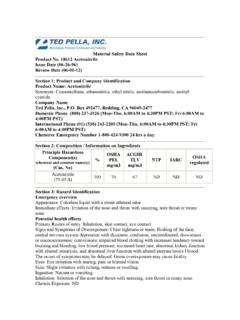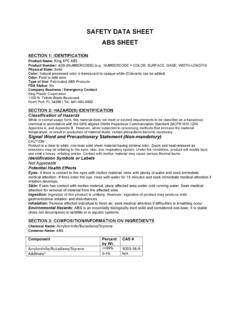Transcription of MATERIAL SAFETY DATA SHEET - Cisco, Inc
1 Form # 853020 Revised: 8/10/05 Supersedes: 7/1/05I. PRODUCT IDENTIFICATIONC hemical Trade Name (as used on label):Chemical Family/Classification:Lead-Acid BatteryElectric Storage BatteryManufacturer's Name/Address:Telephone:EnerSys For information and emergencies, contact EnerSys' Box 14145 Environmental, Health & SAFETY Dept. at 610-208-19962366 Bernville Road24-Hour Emergency Response Contact:Reading, PA 19612-4145 CHEMTREC DOMESTIC: 800-424-9300 CHEMTREC INT'L: 703-527-3887II. HAZARDOUS INGREDIENTS/IDENTIFY INFORMATIONCAS NumberApproximate % by Wt. Or Lead Compound:Lead7439-92-16050150100* Antimony7440-36-02500500--* * * (Sulfuric Acid)7664-93-910-30100010001000 Case MATERIAL :5-10N/AN/AN/APolypropylene9003- 07-0 Polystyrene9003-53-6 Styrene Acrylonitrile9003-54-7 Acrylonitrile Butadiene Styrene9003-56-9 Styrene Butadiene9003-55-8 Polyvinylchloride9002-86-2 Polycarbonate, Hard Rubber, Polyethylene--Other:Silicon Dioxide (Gel batteries only)7631-86-920-40N/AN/AN/ASheet Molding Compound--N/AN/AN/A(Glass reinforced polyester)Inorganic lead and electrolyte (sulfuric acid) are the primary components of every battery manufactured by EnerSys.
2 Other ingredients may be present dependent upon battery type. Contact your EnerSys representative for additonal PHYSICAL DATAE lectrolyte:Boiling Point:203 - 240 FSpecific Gravity (H2O = 1) to Point:N/AVapor Pressure (mm Hg):10 Solubility in Water:100%Vapor Density (AIR = 1):Greater than 1 Evaporation Rate: (Butyl Acetate = 1)Less than 1% Volatile by Weight:N/AAppearance and Odor:Manufactured article; no apparent odor. Electrolyte is a clear liquid with a sharp, penetrating, pungent FIRE AND EXPLOSION HAZARD DATAF lash Point: N/AFlammable Limits: LEL = (Hydrogen Gas)UEL = Media: CO2; foam; dry chemicalSpecial Fire Fighting Procedures: If batteries are on charge, shut off power. Use positive pressure, self-contained breathing apparatus.
3 Water applied to electrolyte generatesheat and causes it to spatter. Wear acid-resistant Fire and Explosion Hazards:Highly flammable hydrogen gas is generated during charging and operation of batteries. To avoid risk of fire or explosion, keep sparks or othersources of ignition away from batteries. Do not allow metallic materials to simultaneously contact negative and positive terminals of cells andbatteries. Follow manufacturer's instructions for installation and REACTIVITY DATAS tability: StableConditions To Avoid: Prolonged overcharge; sources of ignitionIncompatibility: (Materials to avoid)Sulfuric Acid: Contact with combustibles and organic materials may cause fire and explosion. Also reacts violently with strong reducing agents,metals, sulfur trioxide gas, strong oxidizers and water.
4 Contact with metals may produce toxic sulfur dioxide fumes and may release flammablehydrogen Compounds: Avoid contact with strong acids, bases, halides, halogenates, potassium nitrate, permanganate, peroxides, nascent hydrogenand reducing Decomposition Products:Sulfuric Acid: Sulfur trioxide, carbon monoxide, sulfuric acid mist, sulfur dioxide, and Compounds: High temperatures likely to produce toxic metal fume, vapor, or dust; contact with strong acid or base or presence of nascenthydrogen may generate highly toxic arsine Exposure Limits (ug/m3)ComponentsMATERIAL SAFETY data SHEETPage 1 Form # 853020 Revised: 8/10/05 Supersedes: 7/1/05 MATERIAL SAFETY data SHEETVI. HEALTH HAZARD DATAR outes of Entry:Sulfuric Acid: Harmful by all routes of Compounds: Hazardous exposure can occur only when product is heated, oxidized or otherwise processed or damaged to create dust, vapor or :Sulfuric Acid: Breathing of sulfuric acid vapors or mists may cause severe respiratory Compounds: Inhalation of lead dust or fumes may cause irritation of upper respiratory tract and :Sulfuric Acid: May cause severe irritation of mouth, throat, esophagus and Compounds: Acute ingestion may cause abdominal pain, nausea, vomiting, diarrhea and severe cramping.
5 This may lead rapidly to systemictoxicity and must be treated by a Contact:Sulfuric Acid: Severe irritation, burns and Compounds: Not absorbed through the Contact:Sulfuric Acid: Severe irritation , burns, cornea damage, and Components: May cause eye of Overexposure - Acute:Sulfuric Acid: Severe skin irritation, damage to cornea, upper respiratory irritation. Lead Compounds: Symptoms of toxicity include headache, fatigue, abdominal pain, loss of appetitie, muscular aches and weakness, sleepdisturbances and of Overexposure - Chronic:Sulfuric Acid: Possible erosion of tooth enamel, inflammation of nose, throat and bronchial Compounds: Anemia; neuropathy, particularly of the motor nerves, with wrist drop; kidney damage; reproductive changes in males :Sulfuric Acid: The International Agency for Research on Cancer (IARC) has classified "strong inorganic acid mist containing sulfuric acid" as a Category I carcinogen, a substance that is carcinogenic to humans.
6 This classification does not apply to liquid forms of sulfuric acid or sulfuricacid solutions contained within a battery. Inorganic acid mist (sulfuric acid mist) is not generated under normal use of this product. Misuse of the product, such as overcharging, may result in the generation of sulfuric acid Compounds: Lead is listed as a 2B carcinogen, likely in animals at extreme doses. Proof of carcinogenicity in humans is lacking at : Listed by National Toxicology Program (NTP), International Agency for Research on Cancer (IARC), OSHA and NIOSH as a carcinogen only after prolonged exposure at high Conidtions Generally Aggravated by Exposure:Overexposure to sulfuric acid mist may cause lung damage and aggravate pulmunary conditions. Contact of sulfuric acid with skin may aggravatediseases such as eczema and contact dermatitis.
7 Lead and its compounds can aggravate some forms of kidney, liver and neurologic :Sulfuric Acid: Remove to fresh air immediately. If breathing is difficult, give : Remove from exposure, gargle, wash nose and lips; consult :Sulfuric Acid: Give large quanitities of water; do not induce vomiting; consult : Consult physician :Sulfuric Acid: Flush with large amounts of water for at least 15 minutes; remove contaminated clothing completely, including : Wash immediately with soap and :Sulfuric Acid and Lead: Flush immediately with large amounts of water for a least 15 minutes; consult 65:Warning: Battery posts, terminals and related accessories contain lead and lead compounds, chemicals known to the State of California to causecancer and reproductive harm.
8 Batteries also contain other chemicals known to the State of California to cause cancer. Wash hands after PRECAUTIONS FOR SAFE HANDLING AND USES pill or Leak Procedures:Stop flow of MATERIAL , contain/absorb small spills with dry sand, earth, and vermiculite. Do not use combustible materials. If possible, carefullyneutralize spilled electrolyte with soda ash, sodium bicarbonate, lime, etc. Wear acid-resistant clothing, boots, gloves, and face shield. Do notallow discharge of unneutralized acid to Disposal Methods:Spent batteries: Send to secondary lead smelter for neutralized slurry into sealed containers and handle as applicable with state and federal regulations. Large water-diluted spills, afterneutralization and testing, should be managed in accordance with approved local, state and federal requirements.
9 Consult state environmental agency and/or federal AND FIRST AID PROCEDURES: Page 2 Form # 853020 Revised: 8/10/05 Supersedes: 7/1/05 MATERIAL SAFETY data SHEETVII. PRECAUTIONS FOR SAFE HANDLING AND USE (Cont.)Handling and Storage:Store batteries in cool, dry, well-ventilated areas with impervious surfaces and adequate containment in the event of spills. Batteries should also be stored under roof for protection against adverse weather conditions. Separate from incompatible materials. Store and handle only in areas with adequate water supply and spill control. Avoid damage to containers. Keep away from fire, sparks and Labeling:POISON - CAUSES SEVERE BURNSDANGER - CONTAINS SULFURIC ACIDVIII. CONTROL MEASURESE ngineering Controls:Store and handle in well-ventilated area.
10 If mechanical ventilation is used, components must be Practices:Handle batteries cautiously to avoid spills. Make certain vent caps are on securely. Avoid contact with internal components. Wear protectiveclothing when filling or handling Protection:None required under normal conditions. When concentrations of sulfuric acid mist are known to exceed the PEL, use NIOSH or MSHA-approvedrespriatory Gloves:Rubber or plastic acid-resistant gloves with elbow-length Protection:Chemical goggles or face Protection:Acid-resistant apron. Under severe exposure emergency conditions, wear acid-resistant clothing and Flushing:In areas where sulfuric acid is handled in concentrations greater then 1%, emergency eyewash stations and showers should be provided,with unlimited water OTHER REGULATORY INFORMATIONNFPA Hazard Rating for Sulfuric Acid:Flammability (Red) = 0 Reactivity (Yellow) = 2 Health (Blue) = 3 Sulfuric acid is water-reactive if DOT:The transportation of wet and moist charged (moist active) batteries within the continental United States is regulated by the DOT through the Code of Federal Regulations, Title 49 (CFR49).





